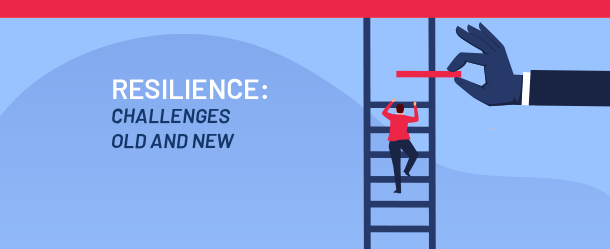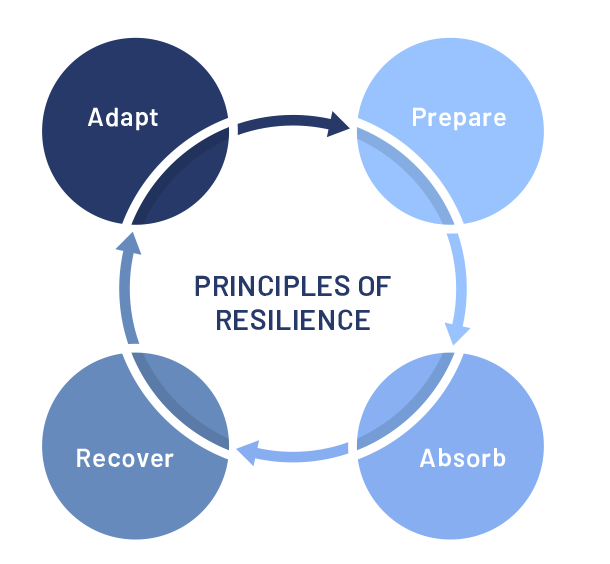



In an earlier blog, we defined “resilience” as:
1. the capacity to recover quickly from difficulties; toughness
2. the ability of a substance or object to spring back into shape; elasticity
The architecture, engineering, and construction (AEC) industry has used the term resilience to refer to a community’s ability to recover from a range of difficulties. Depending on your perspective, a community could be a business entity, municipality, state, or federal agency.
For the last 15 years, resilience in the AEC industry has focused on difficulties driven by climate emergencies such as heavy weather events exacerbated by rising sea levels. But the world has changed over the past nine months, and we are now confronting a global pandemic, economic turbulence, and societal conflict. Fortunately, there is a tried and true framework in place that can be used to focus our industry’s efforts on helping our communities take on these new challenges.
The Department of Defense (DOD) has been a leading federal agency in identifying resilience as a critical initiative. A best practice in the DOD is the U.S. Army Corps of Engineers (USACE) framework for understanding resilience: Prepare, Absorb, Recover, and Adapt. These four simple but powerful principles give planners a helpful structure to improve resilience, and a way forward for resilience challenges now and into the future.

Per the USACE’s guidance, this principle stresses wise and rapid repair or functional restoration. This is relatively straightforward: in the wake of a flooding event or other natural disaster, one of the immediate requirements is to return to mission-capable status. But if you step back and look at the larger cycle of resilience, you can see that decisions you make in the recovery effort can impact the work you do in later phases as your organization seeks to adapt to future challenges and disruptions.
This principle refers to modifications to a project component or system that maintains or improves future performance based on lessons learned. This phase is the key inflection point in the resilience cycle – when an organization can transform a standard damage repair operation into an investment in its future.
Adapting means that you do not simply replace damaged facilities and infrastructure: you make deliberate decisions to fortify against future disruptions or avoid them altogether. For example, MBP supported New Jersey’s Reconstruction, Rehabilitation, Elevation, and Mitigation (RREM) program in the aftermath of Superstorm Sandy. Much of this work involved rebuilding homes along the Jersey Shore with elevated structures to raise the living spaces above sea level (e.g. car parking below the main house structures). It also included building living shorelines using plant life to stabilize beach areas. Living shorelines have proven to be excellent mitigation strategies for sea level rise because they absorb wave energy and are more resilient to increased tidal surge and recurrent flooding events than traditional bulkheads.
As we built new adaptable infrastructure, we also learned that recovery work must look across different specialties to create innovative solutions: civil/structural engineering, marine/littoral botany, etc.
In many ways, the Prepare principle in the resilience cycle is where much of the “traditional” work in the realm of resilience happens. This phase represents work that communities do to make themselves better able to handle future disruptions. Earlier this year, MBP began assisting the City of Norfolk on a $95 million project to prepare for expected flooding events of greater frequency and intensity. Norfolk recently won the U.S. Department of Housing and Urban Development’s National Disaster Resilience Competition to fund this project. This work builds new resilient infrastructure including amenities, municipal infrastructure, and environmental features to improve community connectivity and add natural habitat along the Ohio Creek.
This project started in January 2020 and is expected to finish in April 2023. As we took on this project, we realized it is a great example of targeted and thoughtful infrastructure investments that simultaneously improve communities and increase resilience to flooding and heavy weather events. We view this as a great example of value stacking – an idea borrowed from other disciplines that refer to projects that bring more than one value stream to bear. This project protects the city from recurring flooding events of the Ohio Creek while simultaneously improving the community’s quality of life.
The City of Norfolk is on the leading edge of resilience efforts nationwide, and we look forward to continuing to work with them on this project and others to help our community become a more resilient and enjoyable place to live.
In the framework of resilience, the Absorb phase is almost self-explanatory: the ability of an entity to endure a given disruption or incident. Now we have a new crisis that our communities are still “absorbing” – the COVID-19 public health emergency.
The AEC industry leaped into action to help communities absorb the disruption wrought by the pandemic. One prominent example was when USACE and other entities rapidly built temporary medical facilities around the country. These facilities prevented healthcare catastrophes by providing short-term, additional capacity for heavily impacted communities. SAME Resilience Community of Interest Chairman Joe Manous refers to this as “failing with grace.” These facilities took on crushing caseloads of COVID-19 patients, but the added capacity helped them continue to provide critical healthcare in difficult, but safe conditions. Resilience is not simply the ability to adapt to sea-level rise, it is the ability to take a hit, “fail gracefully,” and recover quickly from difficulties of all shapes and sizes.
MBP has a growing portfolio of projects in the resilience arena as we continue to help our communities confront the challenges posed by climate change and sea level rise. Our work over the years has given us a framework for planning with an eye toward resilience and has enhanced our company’s existing culture of integration and collaboration. We look forward to partnering with our federal, state, and local governments and other organizations to prepare for the future. We will work with them to transform our communities into resilient places that absorb emergencies, recover quickly, and adapt to whatever challenges lie ahead.
Related Readings:
Construction in Uncertain Times (and 7 Ways to Come Back Even Stronger)
How Sandy Has Forced Us to Become More Resilient
Comments